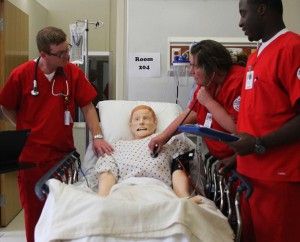Medical simulators provide nursing majors experience

April 15, 2013
Hands-on experience is a key element for students in nursing programs, and a new program allows university students to gain experience without tending to a single human patient.
The SIU-Edwardsville Nursing Simulation Laboratory at Lindegren Hall, part of a partnership between both SIU campuses, gives nursing students the opportunity of hands-on practice without the risk of injuring a human by using computer simulated “patients.” To boost program interest, an open-house tour took place Wednesday.
The SIUE Nursing program is run through Carbondale’s campus because of the difficulty to start up a program, said Susan Winters, director of the SIUE Regional Nursing Program. Both SIU campuses pooled their resources to bring nursing education to southern Illinois, she said, as there was no nursing program below Interstate 64 before the collaboration.
Advertisement
“Starting a nursing program is very expensive, and (it is) hard to find faculty,” Winters said.
The lab contains six different simulated mannequins, which have existed for three or four years, Winters said. Of the six, two are adult males, two are adult females, one is a 6-year-old patient and one is an infant child. Lab coordinator Erin McGuire said each simulated patient acts similarly to how a normal patient would — They cry, moan, cough, have trouble breathing and answer questions by saying yes or no. The simulated patients can even have seizures.
McGuire said one of the female mannequins, Noelle, can give birth to an infant child mannequin.
The other female mannequin allows students to practice changing a catheter, taking blood pressure and giving an IV, she said.
However, there is one patient that sticks out from the rest: Aggy. McGuire said that through more advanced technology, Aggy has the ability to blink, cry water tears, sweat when he has a fever, talk and die. His pupils react to light to show dilation, his chest moves up and down to show how much he is breathing and he has pulses in every part of the body that a normal male human would, she said.
When students learn how to change catheters, Aggy might wet the bed. Aggy can bleed as well, and this is all controlled by a tablet known as a SimPad, McGuire said.
If a student forgets to do something for their patient, such as lowering their beds or making sure the call button is in reach, McGuire can let the student know if he or she forgot something. The SimPad is also wireless, so McGuire does not have to be in the same room to activate patient reactions, McGuire said.
Advertisement*
After each situation the students have with a patient, they go through a debriefing process. This lets students talk about what they just experienced, McGuire said.
It’s all about letting students make mistakes in a safe environment, rather than in the real world on a real patient, she said. These patients help the students gain confidence and really get a hands-on feel for what they will do in the future, McGuire said.
Winters said even though the students know the mannequins are fake, the “patients” are treated as genuine.
“We try making them as realistic as possible, knowing that this is not a real person, but realistic enough so that they can get engaged in the situation where they suspend disbelief,” Winters said.
Despite the classroom setting, several students said the simulators provide the real-world experience they need.
Kaylee Cole, a senior from Mount Carmel studying nursing, said the first time she saw a simulated patient seize up, she knew what to do but had difficulty performing.
“You just kind of forget everything,” Cole said.
Grant Hamilton, a senior from Algonquin studying nursing, said his first simulator experience was nerve-wracking and his knees felt like they were going to lock up while he worked. However, the patients have helped him prepare for clinicals, he said.
Advertisement







